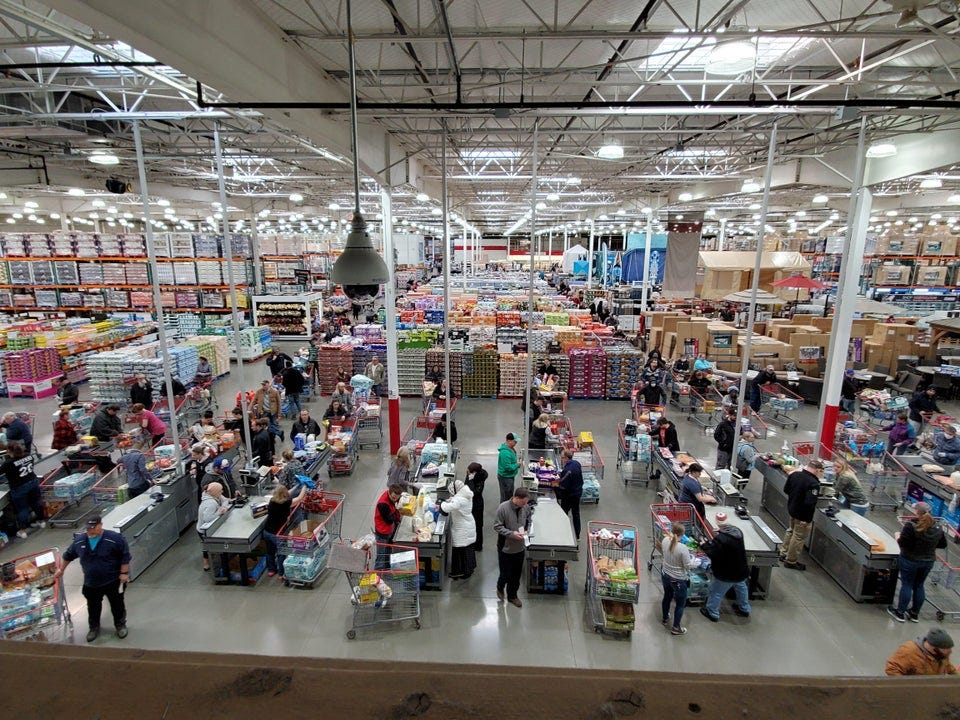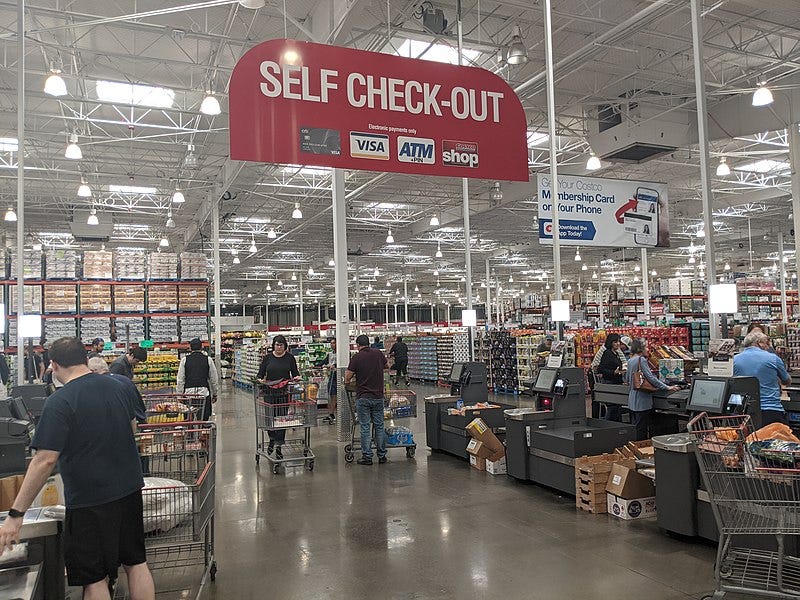Product expectations = customer experience
"Everything Starts Out Looking Like a Toy" #98

Hi, I’m Greg 👋! I publish this newsletter on finding data products and interesting data observations with the goal of finding patterns and future product insights. (Also, it’s fun.) If you need a background on how we got here, check out What is Data Operations?
This week’s toy is a LEGO Space brick with a working display. (So cool!)
Edition 98 of this newsletter is here - it’s June 20, 2022.
The Big Idea
A short long-form essay about data things
⚙️ Product Expectations = Customer Experience

One way to learn about product-led growth is to observe it in the wild. What do people do when they get real-world cues during a product flow? Do they continue and try again, or do they balk and refuse to continue?
The product experience is driven by customer expectations of what should happen because it defines whether or not the customer believes the outcome was a success. Customers remember the outcome of the interaction, and that provides the basis for future experiences. Improving this loop requires you to understand key points of the customer’s motivation.
For example, what would make a busy Costco more enjoyable? One thing could be delivering the same merchandising experience to the customer while lowering the time spent in an unpleasant portion of the store: the checkout line. In theory, this could improve the bottom line of the store by moving more merchandise and shoppers while maintaining the same brand image.
Costco is known for several things:
Really large stores where you can buy giant quantities of stuff if you are a member
A relatively limited number of items compared to other stores
Incredibly long lines when things get busy
A very high level of customer service
Treating employees better than the average big-box store
Is a self-checkout consistent with this brand experience?
The Costco Customer Experience
When you walk into a Costco store, they ask you for a membership card and greet you into a giant store. While pushing an oversize cart, you navigate through a number of very large aisles in a warehouse. There are many name-brand items present, and you are expected to find what you need, place it in your cart, and go to the checkout line area.
If you’ve ever experienced the feeling of line-balk when you go to the coffee shop, you probably also feel it when the Costco checkout looks like this.

Enter a Product Innovation: Self Checkout
The typical customer “visits Costco on a weekend day every two to three weeks — about 23 trips per year — and picks up nine products for a total cost of about $114 a trip.” (Business Insider)
Incrementally improving the average basket size or the speed of the transaction will have a material effect on Costco’s profits, so it’s natural that they turned to a self-checkout model to improve flow in the stores, especially for the average customer who visits frequently and doesn’t have that many items in their cart.


They also restrict the self check-out to automatic payments only, removing some of the need for cashier oversight. Makes sense, right?

A New Customer Behavior: Scan and Pack
Asking you to scan and place your own groceries makes sense in a grocery store, and is slightly weird in a Costco.
First, you scan your membership card (Parallel to what you would do in a regular line)
Then, take your stuff out of the cart, and scan it. (This part makes sense)
For each item, place it into the holding area (This part mostly makes sense, but you can’t bag or box it while you are scanning)
Then, you carefully arrange the stuff in an area smaller than the cart so that all of the items don’t touch and none of them leave the area (This part is clearly based on the technology used to make sure you aren’t adding stuff that you don’t pay for)
Follow the instructions, and you can use the appropriate payment method to pay and get a receipt you use to exit the store having proven payment.
What makes sense:
scanning your groceries - no biggie!
adding multiple stations where you can check out - no more line waits!
What doesn’t work? If you deviate from the expected behavior … at all.
Breaking the experience
This is a Costco Reward Certificate.
Although it says that it is redeemable at Costco, and has a bar code that you can scan at the self-checkout, it is apparently not a form of electronic payment that is accepted at a Costco checkout.
🚨🚨 Find a clerk, your transaction is stopped 🚨🚨
Doesn’t this seem pretty odd? Costco has around 110 million cardholders.
Assuming that 10-20% of them spring for the Executive Membership, that’s 10-20 million interactions where these checks could be used annually.
if 80% of the checks are redeemed and 20% of the people in store use the self checkout, we’re still talking about 1-2 million interactions that are happening a year where this could have a negative impact.
The people who get the most benefit from this reward are the most profitable users of Costco
Clearly, either adding a prompt to the self-check letting you know that you need to go to membership or … letting the self-checkout accept the reward certificate were not good options for some reason.
Other issues: items that scan easily
If you happen to have a very large item, you’ll need to scan it by lifting it onto the scanning area as there are no portable scanners available to find the bar code on your very large item.
🚨🚨 Find a clerk, your transaction is stopped 🚨🚨
What if you want to pack your stuff?
If you are in the habit of boxing your items while you are checking out like you do in a normal line, you need to wait until you pay to box and arrange them. You can’t box while you scan, or the system will complain.
🚨🚨 Find a clerk, your transaction is stopped 🚨🚨
As a Costco shopper, the experience of going through a self-checkout lane is very different than queuing for a line, speaking to the checker, giving them your card, and then paying as they (or you) pack the results. Instead of making it easier for you to give them more money, Costco is making it harder for you to complete the transaction, in order to avoid the negative product outcomes (loss management, long lines, cost of staffing) that might otherwise occur.
Setting customer expectations for your product
If Costco is the model, what learning do we get from watching this particular product experience?
Here are a few thoughts to improve the chance that customer expectations will be echoed in the product experience:
1. Avoid “everything is easy” when some things are complex
Some shoppers (or product buyers) are willing to tolerate a complex process like self-checkout to get a clear benefit (self-control, faster exit from the store). There are other customers who will go through this process and completely balk. When they experience an edge case like “electronic money from Costco that is not accepted as electronic money except at customer service”, they may choose to go to another store or product rather than figuring it out.
2. Tell people exactly what they need to do to succeed
“Power users will figure it out” doesn’t cover most of the users. Even at Costco. Use the tools at your disposal (overlays, guides, intro text, examples, and more) to suggest what the user needs to do to succeed. Without that, the product experience of 🚨🚨 Find a clerk, your transaction is stopped 🚨🚨 is pretty awful.
Documentation and microcopy goes a long way here toward improving how people feel, especially when they are tired, distracted, or need to do something on a time pressure.
3. Reinforce your product’s North Star ⭐️
What customers expect … becomes your product experience. If this equation is incongruent or fails, they are going to feel that your product experience is lousy. By telling them what you’re going to deliver, making sure you deliver that thing, and letting them know the guideposts along the way, you increase the chance of delivering a truly excellent experience.
What’s the takeaway? When you’re adding a new thing to an existing product or changing an existing process, empathy is critical in understanding the ways people feel when they experience the change. Simply doing the thing may not be enough: you may need to build scaffolding or change the process to accommodate edge cases and existing customers.
Links for Reading and Sharing
These are links that caught my 👀
1/ Systems thinking for designers - Tanner Christensen shares this excellent short piece about thinking in systems. Design that follows this, Christensen writes, “resolves problems without negatively affecting anything else in its ecosystem.” The ability to take 1+1 and make it feel like more than 2 is the magic of a great designer.
2/ Build curriculum, not content - Andy Crestodina writes that building curriculum helps bridge the gap between informational content that is only good for some personas and externally facing content that helps you build your brand.
3/ Fighting cognitive dissonance - Why do things feel like they don’t match? John Cutler made a great list of all of the reasons you might think things sound weird.
What to do next
Hit reply if you’ve got links to share, data stories, or want to say hello.
I’m grateful you read this far. Thank you. If you found this useful, consider sharing with a friend.
Want more essays? Read on Data Operations or other writings at gregmeyer.com.
The next big thing always starts out being dismissed as a “toy.” - Chris Dixon






